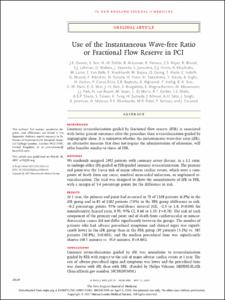KUMEL Repository
1. Journal Papers (연구논문)
1. School of Medicine (의과대학)
Dept. of Internal Medicine (내과학)
Use of the Instantaneous Wave-free Ratio or Fractional Flow Reserve in PCI
- Keimyung Author(s)
- Nam, Chang Wook
- Department
- Dept. of Internal Medicine (내과학)
- Journal Title
- New England Journal of Medicine
- Issued Date
- 2017
- Volume
- 376
- Issue
- 19
- Abstract
- BACKGROUND
Coronary revascularization guided by fractional flow reserve (FFR) is associated
with better patient outcomes after the procedure than revascularization guided by
angiography alone. It is unknown whether the instantaneous wave-free ratio (iFR),
an alternative measure that does not require the administration of adenosine, will
offer benefits similar to those of FFR.
METHODS
We randomly assigned 2492 patients with coronary artery disease, in a 1:1 ratio,
to undergo either iFR-guided or FFR-guided coronary revascularization. The primary
end point was the 1-year risk of major adverse cardiac events, which were a composite
of death from any cause, nonfatal myocardial infarction, or unplanned revascularization.
The trial was designed to show the noninferiority of iFR to FFR,
with a margin of 3.4 percentage points for the difference in risk.
RESULTS
At 1 year, the primary end point had occurred in 78 of 1148 patients (6.8%) in the
iFR group and in 83 of 1182 patients (7.0%) in the FFR group (difference in risk,
−0.2 percentage points; 95% confidence interval [CI], −2.3 to 1.8; P<0.001 for
noninferiority; hazard ratio, 0.95; 95% CI, 0.68 to 1.33; P = 0.78). The risk of each
component of the primary end point and of death from cardiovascular or noncardiovascular
causes did not differ significantly between the groups. The number of
patients who had adverse procedural symptoms and clinical signs was significantly
lower in the iFR group than in the FFR group (39 patients [3.1%] vs. 385
patients [30.8%], P<0.001), and the median procedural time was significantly
shorter (40.5 minutes vs. 45.0 minutes, P = 0.001).
CONCLUSIONS
Coronary revascularization guided by iFR was noninferior to revascularization
guided by FFR with respect to the risk of major adverse cardiac events at 1 year. The
rate of adverse procedural signs and symptoms was lower and the procedural time
was shorter with iFR than with FFR. (Funded by Philips Volcano; DEFINE-FLAIR
ClinicalTrials.gov number, NCT02053038.)
- Keimyung Author(s)(Kor)
- 남창욱
- Publisher
- School of Medicine
- Citation
- J.E. Davies et al. (2017). Use of the Instantaneous Wave-free Ratio or Fractional Flow Reserve in PCI. New England Journal of Medicine, 376(19), 1824–1834. doi: 10.1056/NEJMoa1700445
- Type
- Article
- ISSN
- 0028-4793
- Appears in Collections:
- 1. School of Medicine (의과대학) > Dept. of Internal Medicine (내과학)
- 파일 목록
-
-
Download
 oak-2017-0329.pdf
기타 데이터 / 225.26 kB / Adobe PDF
oak-2017-0329.pdf
기타 데이터 / 225.26 kB / Adobe PDF
-
Items in Repository are protected by copyright, with all rights reserved, unless otherwise indicated.